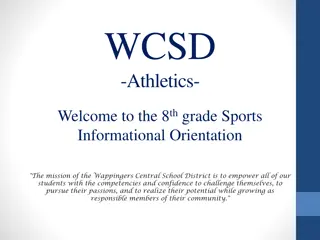Sports Mania Returns: Fans, Venues, and Trends
Despite the challenges of the 2020 sports season, fans are eagerly following major sports leagues while also showing increased interest in lesser-known sports. This article discusses the resurgence of live sports attendance, viewer demographics, the booming esports industry, and the rise of sports betting across different states.
Download Presentation

Please find below an Image/Link to download the presentation.
The content on the website is provided AS IS for your information and personal use only. It may not be sold, licensed, or shared on other websites without obtaining consent from the author.If you encounter any issues during the download, it is possible that the publisher has removed the file from their server.
You are allowed to download the files provided on this website for personal or commercial use, subject to the condition that they are used lawfully. All files are the property of their respective owners.
The content on the website is provided AS IS for your information and personal use only. It may not be sold, licensed, or shared on other websites without obtaining consent from the author.
E N D
Presentation Transcript
Sports Mania Returns Despite the forgettable 2020 sports season, fans continue to follow the major sports, according to January 2022 research from the Sports & Leisure Research Group: football at 88%, basketball at 60%, baseball at 53%, hockey at 30% and soccer at 29%. The interruption in the sports world increased interest in lesser sports. According to Sports & Leisure Research Group, from April 2020 to January 2022, golf increased by 17%, NASCAR by 25%, horse racing by 29% and MMA by 57%. The pandemic didn t stop many leagues from signing new media rights deals, including the NFL s 11-year, $100 billion deal, which awarded Amazon Prime Thursday Night Football. The NHL has switched to Disney and Turner Sports at $625 million per year in a new deal.
Venues Are Filled with Fans Again The pandemic drastically restricted sports attendance, but average attendance during the first few games of the 2022 MLB season has doubled or almost doubled for some teams: Los Angeles Angels at +83.9% and St. Louis Cardinals at +125.8%, for example. Similarly for the NBA, the New Orleans Jazz which had the largest average attendance during the 2021 season of 3,675 increased almost three-fold to 18,306 for 2022 while the Chicago Bulls which had no 2021 home games was first for 2022 with an average of 20,881. The Sports & Leisure Research Group also revealed a much larger percentage had attended a sporting event during January 2022 at 37% than January 2021 at 21%. Approximately half said they were still wearing masks to indoor sporting events.
Viewing from the Home s Box Seats Data from five 2021 representative consumer/market surveys conducted by The Media Audit shows the oldest average age of adults 18+ who watched any major professional or college sports on TV during the past 12 months was college basketball at 52.2. Unsurprisingly, the next oldest were those watching MLB games at 51.2 years of age and the NFL at 51.1 years of age. The youngest were those viewing NBA games at 45.7, then MLS at 46.2 and NHL at 49.0 years of age. In these five markets, adults 18+ who watched the NHL on TV during the past year had the largest average household income of $79,200, followed by MLS at $78,700, college basketball at $78,300 and MLB at $77,500.
Esports Is Exploding According to NewZoo s April 2022 Global Esports Report, the global esports audience will increase 8.7% during 2022 to a total of 532.0 million and will increase to 640.8 million by 2025. Total 2021 global esports revenues are forecast to increase 21.8% to $1.38 trillion. A slightly different set of five 2021 representative consumer/market surveys from The Media Audit shows almost 80% of men (78.4%) were esports fans and of all adults 18+, 66.8% were 25 44 years of age. While the average household income of all esports fans 18+ was $70,500, the average household income of Millennials who were esports fans was $78,200 and the average household income of men 25 44 who were esports fans was $80,400.
Sports Betting Is a Winner With live, legal sports betting in 30 states and Washington, DC, three states where it s legal, but not in operation and nine states where legislation or voting is pending, it s no surprise February 2022 sports betting totaled $360.2 million, a 55.6% increase from February 2021. Insider Intelligence/eMarketer is forecasting 19.0 million Americans will be betting on sports online during 2022, which is 7.9% of all adult Internet users, increasing 31.0% from 2021. By 2023, the total number of online sports bettors could increase to 23.1 million. Analyzing data from The Media Audit s same five 2021 consumer/market surveys on page 2 of the Profiler reveals 78.7% of adults who placed sports wages monthly online or via a mobile app one or more times were men and Millennial men over-index the most.
Fast-Track Trends PwC s 2022 Sports Outlook Report cites NFTs (non- fungible tokens) as a growing trend in the sports market. Not only are there more collectible, limited-edition NFTs based on classic sports events and players, but also NFT companies are creating digital trading cards. Sports teams are also limiting their exposure to and attraction of Gen Zers because teams are not creating and sharing enough short-form video content, which is very popular with the youngest adults. Although more live sports broadcasts have moved from traditional TV to streaming services, many US teams may have to follow the trend in Europe where free streaming services have become very popular with sports fans to watch games.
Advertising Strategies Local businesses and advertisers can partner with their local professional sports teams and ask teams and players to participate in businesses regular volunteer/community involvement projects to create brand awareness for the business and the team. Local businesses and advertisers can also partner with local professional sports teams to help boost interest among women, young adults and families with children by providing discounted tickets for a weekend game. Many of the top college athletes are signing NIL (name, image, likeness) large contracts. Local retailers can consider similar arrangements with lesser-known college athletes, including women, to provide them an opportunity to be retailers spokespersons.
New Media Strategies Research in the Profiler shows teams must improve their engagement with Gen Z adults and short-form video content is what attracts them. Teams can invite young adults via social media to share their recent attendance at a game and how they support their team. As teams and players participate in NFT companies digital trading card products, teams and players can use social media to announce that participation, provide updates when the cards will be available and then offer them for sale via the team s Website or social media pages. Teams located in states with legal sports betting and that promote sports betting can use social media to invite more women to participate. Provide a free guide on sports betting and ask women who are sports bettors to share their experiences and provide tips.























